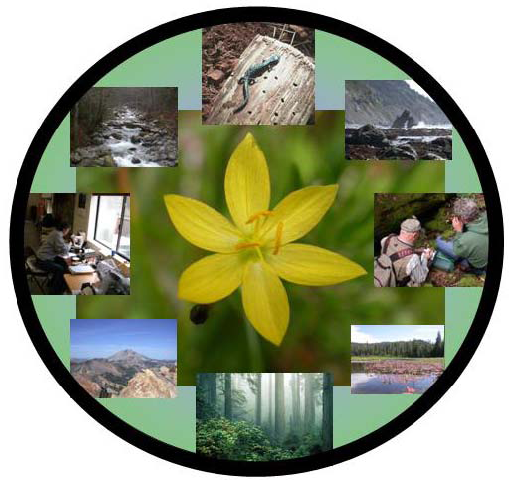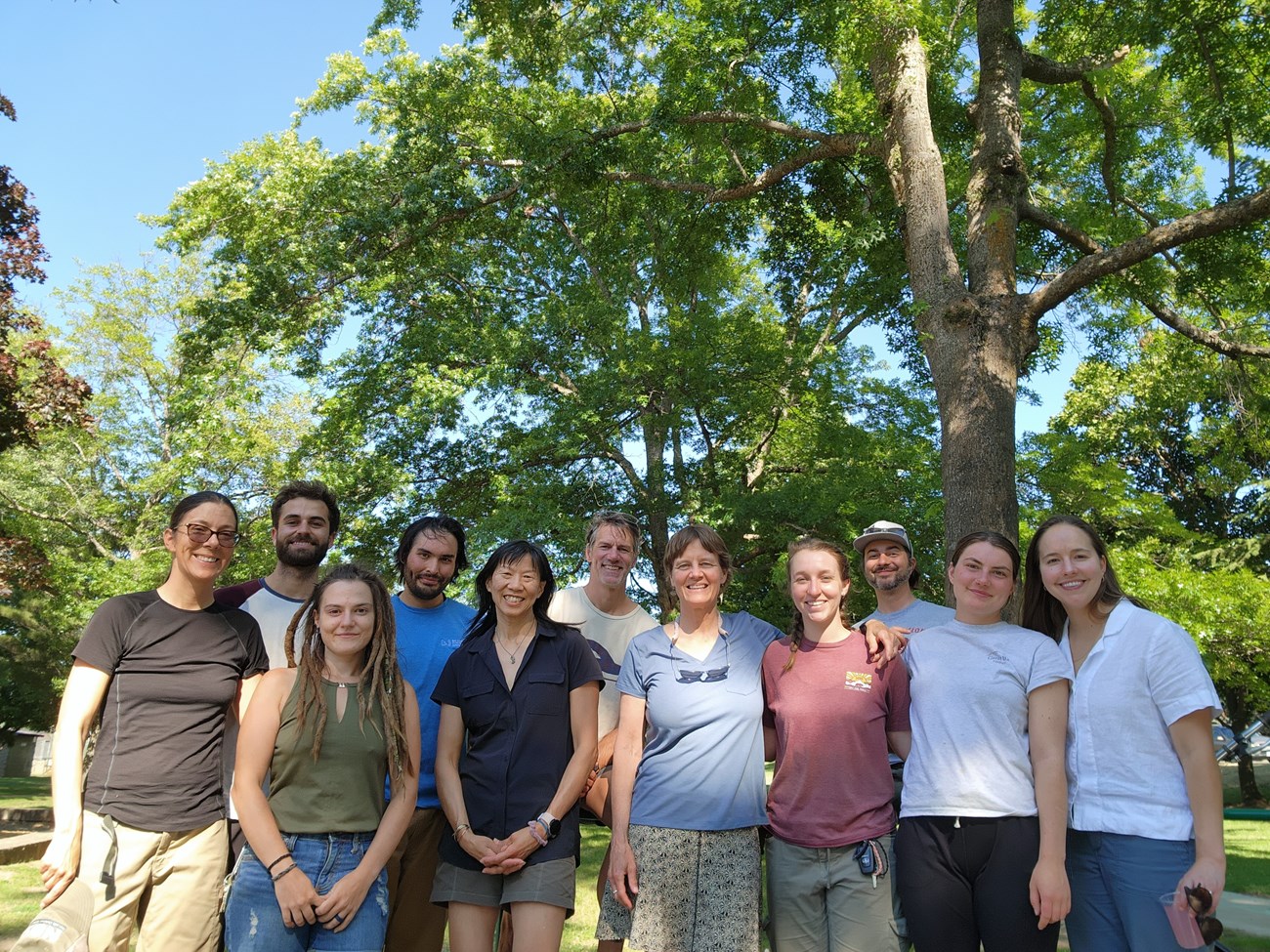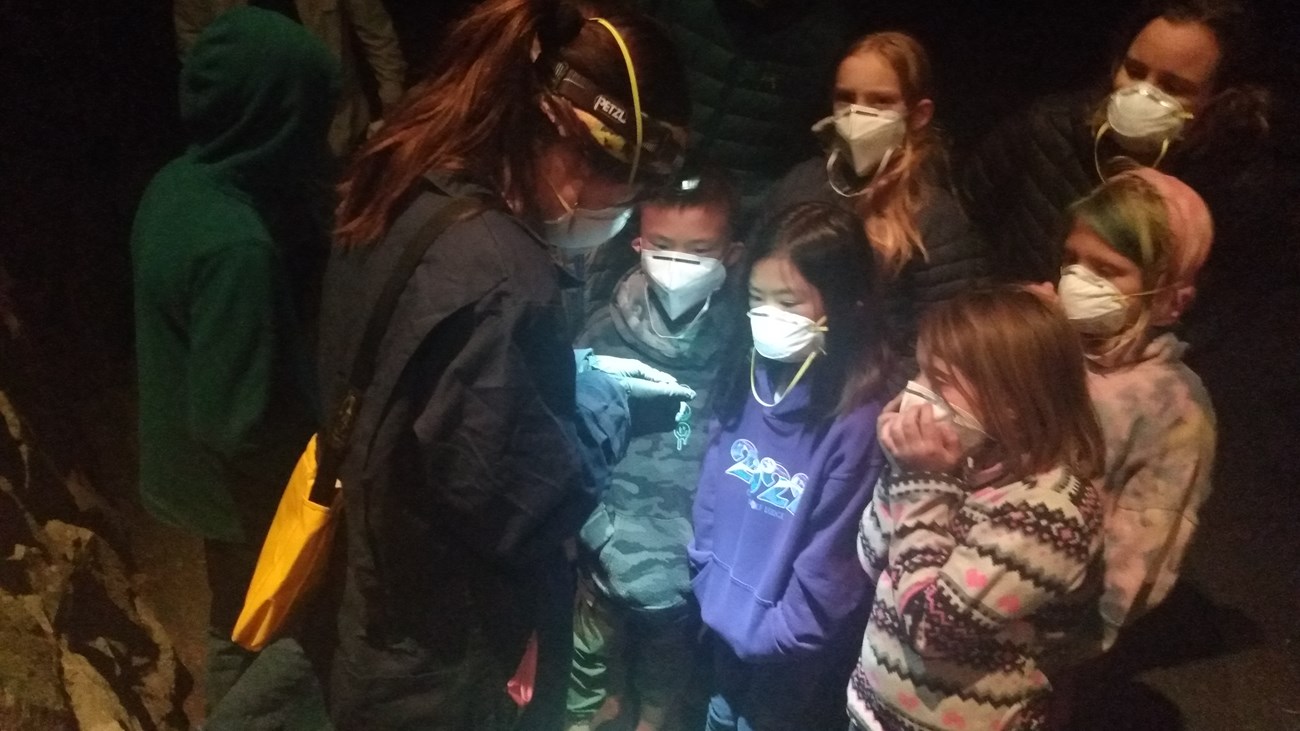Last updated: December 11, 2023
Article
The Klamath Kaleidoscope: Fall-Winter 2023


NPS/Jen Hooke
Whitebark Pine Listed as Threatened under the Endangered Species Act
Effective January 17, 2023, the listing of whitebark pine as a threatened species under the Endangered Species Act starts a new chapter in the story of this iconic tree. The listing triggers specific protections for whitebark pine, as well as a formal recovery plan—currently in development. Restoration efforts have been in motion for years, but the listing takes everything up a notch. It will help boost funding by federal agencies and conservation organizations for restoration projects, such as finding, propagating, and planting trees that are genetically resistant to white pine blister rust, the whitebark pine’s main threat. It will also bring more visibility and hopefully, understanding, to the causes of whitebark pine’s decline: nonnative pathogens (blister rust), native mountain pine beetle population explosions, changing fire regimes, and changing climate conditions.
The Klamath Network, and specifically, Crater Lake National Park, have been part of this story for decades. Crater Lake National Park has been monitoring whitebark pine since the late 1990s, which prompted them to initiate their ongoing blister rust resistance program in 2003 (see Boosting Natural Selection: A Conservation Tool for the Whitebark Pine). In 2005, the Klamath Network selected whitebark pine as 1 of 10 vital signs for monitoring from 172 (!) possible contenders. How did it land in the top 10, especially when all other Klamath Network vital signs are for communities, not single species? Several factors played a role. As a keystone species, its loss would have profound effects. Wildlife depend on its seeds, plants establish more easily in the harsh subalpine zone under its branches, and streams flow longer into the summer thanks to snow slowed from melting under its shady branches. That loss was, and still is, increasingly possible from white pine blister rust, among multiple other threats. It helped that whitebark pine had special appeal to park visitors wowed by its iconic twisty, gnarled shape at the edge of expansive, mountaintop vistas. Practical considerations played a role: it was easy to monitor, and whitebark pine monitoring could integrate with several other networks in the region that were developing five-needle pine (which includes the whitebark pine) vital sign programs. Finally, Crater Lake’s robust monitoring program offered an existing template.
For the past 12 years, Klamath Network crews, including interns from Southern Oregon University, have gathered whitebark pine data at Crater Lake and Lassen Volcanic National Parks. Each plot is visited every three years, and 2023 completed the fourth revisit to all plots in both parks. Documenting whitebark pine reproduction (seedling and cone-bearing tree counts), as well as stressors (damage from blister rust, mountain pine beetle, and other causes) helps managers understand the current condition of whitebark pine in their park and how it may be changing over time. This kind of information helped justify the federal listing decision by documenting, along with other studies, the pervasive decline of whitebark pine. Along with the network’s vegetation map of Crater Lake National Park, the information is also being used to help identify “core restoration” areas for the National Whitebark Pine Restoration Plan—a related but separate planning effort organized by the Whitebark Pine Ecosystem Foundation. Understanding the consequences of climate change, fire, parasites, and disease on shaping whitebark pine communities will prove critical to their protection and conservation in this new chapter as a listed, threatened species.
In the big picture, whitebark pine health here in the southern Cascades is just one piece of a larger puzzle across the species' western US range. The network collaborates with several other networks also monitoring five needle pines—Sierra Nevada, Upper Columbia Basin, and Mojave Desert. (The North Coast and Cascades Network also monitors whitebark pine, though with slightly different methods, and the Greater Yellowstone Network also monitors whitebark pine in the northern Rocky Mountains.)
Sean Smith, former vegetation ecologist for the Klamath Network, finds hope in knowing that the whitebark pine trees surviving now across the West are the ones most likely to be genetically resistant to white pine blister rust—natural selection in action. But the federal listing of this subalpine sentinel as a threatened species also boosts hope for its long-term survival.
Learn more about whitebark pine:
- US Fish and Wildlife Service whitebark pine overview, listing decision, and recovery outline
- In search of rust-resistant whitebark pine trees:
- What we are learning from monitoring:
- Watch this short video clip of a mountain pine beetle stuck in sap, trying to break through a whitebark pine's defenses:
- Duration:
- 13.146 seconds
Mountain pine beetle hindered from entering a boring hole in this whitebark pine. The tree exudes sap - a pitch tube - to fend off attacking beetles.
Farewell and Big Thanks to Jacqueline Lucero

NPS
As any field biologist knows, collecting data successfully in remote, wild settings requires much more than scientific knowledge. Fickle weather can catch you off guard. Unexpected road closures can divert the best laid plans. Power outages in park housing can mean cooking dinner over a camp stove in the dark. All of these challenges (and more) faced the Klamath Network vegetation crew this summer, but they were no match for our interim vegetation monitoring protocol lead, Jacqueline (Jackie) Lucero. Jackie stepped in seamlessly during the search for a permanent vegetation ecologist for the network, ultimately achieving all of our sampling objectives thanks to her botanical knowledge and fieldwork leadership skills.

NPS/Niziolek
Beyond her fieldwork savvy and strong work ethic, Jackie's leadership was marked by warmth and kindness. For example, one morning Jackie surprised her team with fresh pancakes filled with delicious huckleberries (Vaccinium ovalifolium) harvested outside Crater Lake National Park where they were working. Another time, she drove three hours out of her way to retrieve an extra sleeping bag for a crew member who had forgotten one. Jackie left an indelible mark on the network; we are so grateful for her contribution and we are sad to see her go!
Preliminary Effects of the Dixie Fire on Ponds and Lakes
—Eric Dinger

NPS
The 2021 Dixie Fire was one of California’s largest fires ever as of that summer, burning through almost 75% of the ponds and lakes monitored by the Klamath Network in Lassen Volcanic National Park. To understand its impact on the park’s aquatic resources, network crews conducted extra sampling of the ponds and lakes in 2022 before the next long-term sampling season in 2023. We had previously sampled in 2013, 2016, and 2019.
Full analysis of the 2022 data is ongoing, but preliminary results shed some light on the short-term effects of the fire on lake water chemistry and zooplankton communities. One finding was an increase in chloride, a basic chemical in lake water. Lakes that burned (“True” in the figure below) had much higher chloride than lakes that didn’t burn (“False” in the figure). You can also see this pattern by comparing the average change in chloride before and after the Dixie Fire. Chloride increased by an average of 0.23 mg/L for burned lakes but decreased an average of 0.03 mg/L at unburned lakes. Though this level of change is unlikely to affect lake organisms, chloride, as one component of the total dissolved salts (ions) in a lake, is important to track because alterations may indicate changes in watershed processes in the surrounding landscape.
Changes in the water chemistry can cascade into biological resources, like the zooplankton (tiny animals) floating in lake water. However, zooplankton showed no apparent effects from the Dixie Fire. Indeed, as of a year after the fire, burned and unburned lakes had similar levels of species richness (variety of different kinds of zooplankton) (see figure below).

Bottom: Variety of zooplankton species was slightly, but not significantly, higher in ponds and lakes that burned in the Dixie Fire in Lassen Volcanic National Park.
NPS/Dinger

NPS
These preliminary results open some avenues of research into the effects of fire on the aquatic resources of Lassen Volcanic National Park. For example, is there a delayed effect on the zooplankton that we may detect in future years of monitoring? Is there an impact on the lakes from the burned shoreline vegetation? What will be the fate of large snags now dotting the shoreline? How will the amphibian populations respond? What is the difference between the short-term effects and long-term effects, and, importantly, how does that impact how we manage the resource?
Last sampled in 2023, ponds and lakes continue to be monitored in Klamath Network parks as a core vital sign. We will return every three years to continue our monitoring of these valuable resources. Each additional year of data boosts our ability to answer some of these emerging questions about the effects of large fires on park waters and what that means for managing them.
Bats on Stage at Lassen Volcanic National Park

NPS/Niziolek
As white-nose syndrome, the nonnative fungal disease devastating bats in North America, spreads throughout the western United States, scientists are racing to stay one step ahead of it. They are swabbing bats for evidence of the disease, searching for winter bat roosts where the disease may gain traction, and developing protocols to prevent the inadvertent spread of the disease between caves by humans. But protecting bats requires more than science. Public outreach is vital. At Lassen Volcanic National Park this past summer, Klamath Network staff joined other regional bat scientists to help park visitors connect with bats.
A curious crowd of 75 park visitors attended the August 11, 2023, bat evening program. Dylan Rhea-Fournier, Klamath Network bat crew lead, began with an in-depth presentation about bat biology and conservation. He and Dani Niziolek (Klamath Network) showed how to detect bat calls with the SonoBat backpack and fielded lots of questions. Next came bat show-and-tell, where two bats captured that evening at Reflection Pond took center stage. Showing the bats up close to visitors, Dr. Alice-Chung MacCoubrey and Nekai Eversole (Klamath Network), along with Nicole Rose (NW Bat Hub) and other scientists, answered many good questions, offering visitors a chance to personally connect with these remarkable flying mammals:
-
What do bats eat?
-
A large proportion of most bats’ diets includes moths and beetles and other invertebrates that fly around at night.
-
-
How long can the fungus that causes white-nose syndrome last on your clothes?
-
Depends on conditions, but the cold-loving fungus (Pseudogymnoascus destructans) can survive for years in cold temperatures!
-
-
How long before a newborn bat can fly?
-
A pup can grow to full size in 2 to 4 weeks, but then needs another 2 to 4 weeks to learn how to echolocate and fly. So, it generally takes 4-6 weeks to become proficient at flight.
-
-
How does mom fly around with babies hanging off her?
-
She usually has just one pup, and it clings to her underside, but only for a short time after birth, if at all.
-
-
Where can I report a bat colony if I find one rock climbing?
-
Report a bat colony (or a sick bat) to the state wildlife agency
-
Boosting knowledge and personal connection helps visitors see the value of bats and dispels scary myths about this often misunderstood creature. Ideally, it also encourages action. For example, visitors learned how to report a bat colony or a bat with unusual (sick?) behavior. They also learned what to do in answer to this very welcome visitor question, “How do I avoid spreading white-nose syndrome?”
Where Are They Now?

Daniel Chambers
The Klamath Network works with a variety of interns to support our program and to offer educational experiences. Interns may find themselves sampling water quality, monitoring whitebark pine, identifying native plants, mist-netting bats, or writing about our science. Here we highlight where our interns have landed professionally or educationally.
Daniel Chambers
Klamath Network position: lakes and ponds monitoring crew, 2022
Current job: Fisheries Technician, Wyoming Game and Fish Department, Cody, Wyoming
Daniel worked for the Klamath Network as a Southern Oregon University (SOU) intern in the summer of 2022 sampling lakes and ponds at Lassen Volcanic National Park. With little previous experience in the natural sciences, he had a lot to learn. He gained experience using water quality probes and water filtering/alkalinity kits, collecting zooplankton, sampling macroinvertebrates and amphibians, and surveying the lakeside riparian habitat. He also had the opportunity to do some electrofishing with the streams crew one day. Meeting new people and gaining these skills helped him land his current job as a fisheries technician with the Wyoming Game and Fish Department.
As a fisheries technician this past summer, Daniel focused on restoring Yellowstone cutthroat trout in the Bighorn Mountains of Wyoming, camping in remote drainages for up to 8 days at a time. He especially enjoyed the electrofishing part of his job, as well as the bonus opportunity for off-duty fishing, “This summer was also especially great as when we got off work, our camp was within a 1–2 minute walk from some of the best trout habitat there is to fish.” For now, with an Environmental Science and Policy degree from SOU under his belt, Daniel aims to continue building experience as a field biologist working with aquatic resources.
2023 Vital Sign Monitoring Updates

To find out which Klamath Network scientist leads each monitoring program, visit the Contact Us page for the Klamath Network.
Crater Lake National Park
invasive plants
-
In accordance with the recent protocol changes, all park-priority roads, trails, or other segments, such as the park boundary, were surveyed and geospatial data for focal invasive species locations were shared with the park.
lakes
-
Five ponds were surveyed (goal is 6 ponds; one was dry); fourth cycle of sampling.
terrestrial vegetation
-
Completed all 20 alpine sites, all 20 riparian sites, and all 26 matrix (low- to mid-elevation upland) sites.
whitebark pine
-
All 10 sites surveyed.
Lava Beds National Monument
cave monitoring
-
Data collection was successfully completed for cave visitation, climate, and bat monitoring. Winter bat population counts were ~10% higher than the prior year. Due to a staffing shortage, only 2 of 5 ice caves were surveyed. Park and I&M staff are exploring a more efficient, accurate, and less labor intensive, method for ice floor monitoring.
invasive plants
-
In accordance with the recent protocol changes, all park-priority roads, trails, or other segments, such as the park boundary, were surveyed and geospatial data for focal invasive species locations were shared with the park.
landbird point counts
-
Completed all 25 planned routes.
Lassen Volcanic National Park
invasive plants
-
In accordance with the recent protocol changes, all park-priority roads, trails, or other segments, such as the park boundary, were surveyed and geospatial data for focal invasive species locations were shared with the park.
lakes and ponds
-
Twenty-two lake and pond monitoring sites were surveyed (goal is 31 lake and ponds). Fourth cycle of scheduled sampling. Unable to sample all sites due to road damage.
whitebark pine
-
All 10 sites surveyed.
Oregon Caves National Monument and Preserve
cave monitoring
-
Data collection went smoothly. Winter bat count was highest ever, at 109 bats.
invasive plants
-
In accordance with the recent protocol changes, all park-priority roads, trails, or other segments, such as the park boundary, were surveyed and geospatial data for focal invasive species locations were shared with the park.
landbird mist netting
-
The banding station caught 262 birds of 30 species from June 1 to Oct 13. Notable captures included a California Quail and a Black-throated Gray Warbler, both of which are uncommon to the area.
terrestrial vegetation
-
Completed all 10 matrix sites.
Redwood National and State Parks
invasive plants
-
In accordance with the recent protocol changes, all park-priority roads, trails, or other segments, such as the park boundary, were surveyed and geospatial data for focal invasive species locations were shared with the park.
lakes and ponds
-
One site surveyed (Freshwater Lagoon). Fourth sample cycle.
landbird point counts
-
Completed 15 routes (12 planned; 3 oversample).
rocky intertidal zone
-
Sixth year of biodiversity protocol; 19th year of targeted species monitoring. All regularly scheduled sites sampled.
Whiskeytown National Recreation Area
invasive plants
- In accordance with the recent protocol changes, all park-priority roads, trails, or other segments, such as the park boundary, were surveyed and geospatial data for focal invasive species locations were shared with the park.
Recent Publications and Presentations
Publications
Ammann, K., E. C. Dinger, and D. Lohse. 2023. Rocky Intertidal Monitoring: Results from Redwood National and State Parks. Natural Resource Report NPS/KLMN/NRR—2023/2608. National Park Service, Fort Collins, Colorado. https://doi.org/10.36967/2301673.
Wright, M., P. van Mantgem, K. Buffington, K. Thorne, E. Engber, and S. Smith. 2023. Spatially explicit models of seed availability improve predictions of conifer regeneration following the 2018 Carr Fire in northern California. Front. Ecol. Evol. 11:1229123. https://doi.org/10.3389/fevo.2023.1229123
Park Presentations
Face to Face Briefings allow Klamath Network staff to present detailed results from annual monitoring of vital signs with park staff. The briefings are conducted either in person or via a Teams call, and provide time for questions and dialogue. We invite interpreters and other park staff outside of resource management to join the higher level overview at the start of each briefing and to read the 2-page public-friendly brief that accompanies each briefing.
-
On September 21, 2023, Dr. Eric Dinger, aquatic ecologist with the Klamath Network, presented detailed results to Crater Lake NP staff from monitoring streams in 2021 and lakes in 2019. View the 2-page streams brief and lakes brief associated with the presentation.
Science Communication
Featured Creature natural history articles (quarterly schedule):

Newsletter prepared by Sonya Daw
NPS Klamath Inventory & Monitoring Network
Southern Oregon University
1250 Siskiyou Blvd
Ashland, OR 97520
To view past issues of this newsletter, please visit the Klamath Kaleidoscope Newsletter page on our website.
